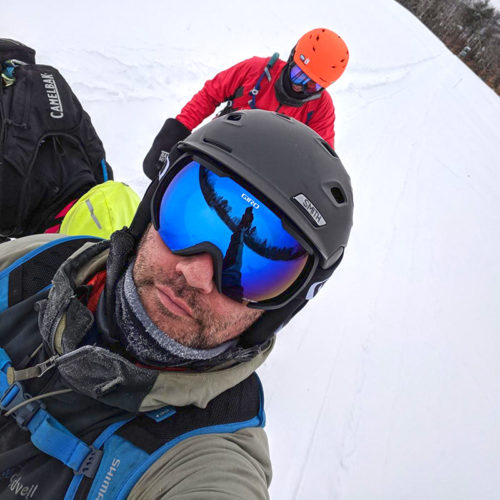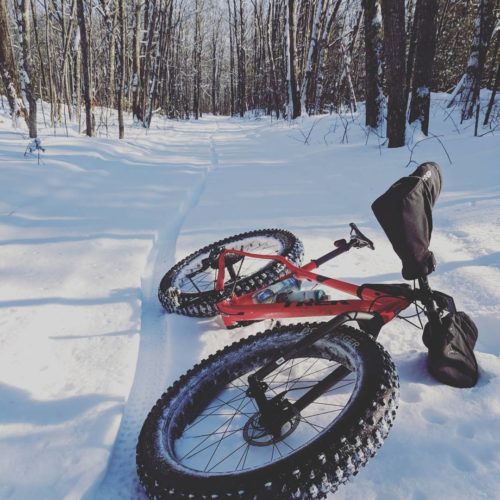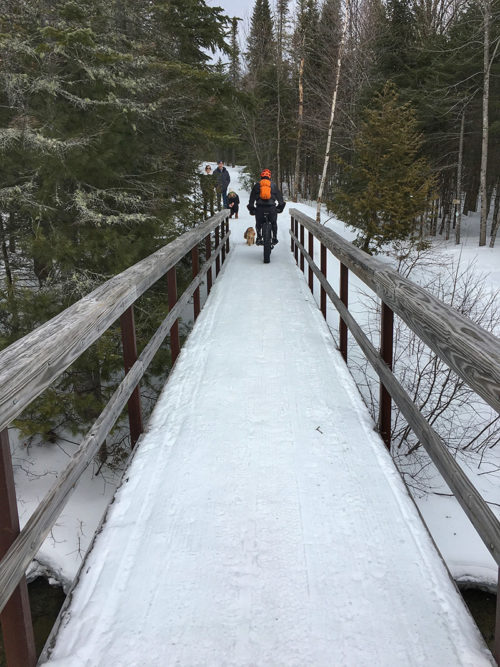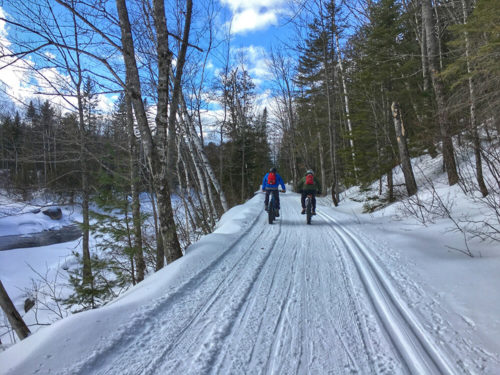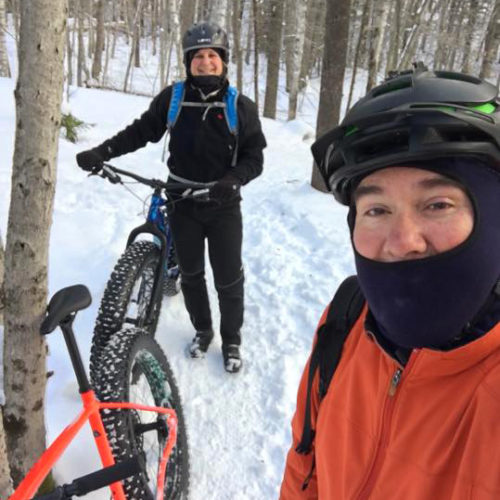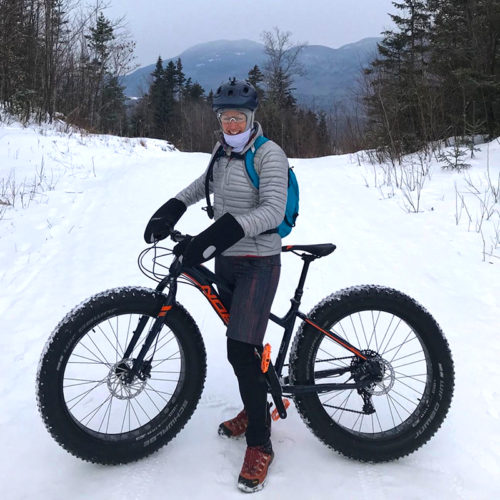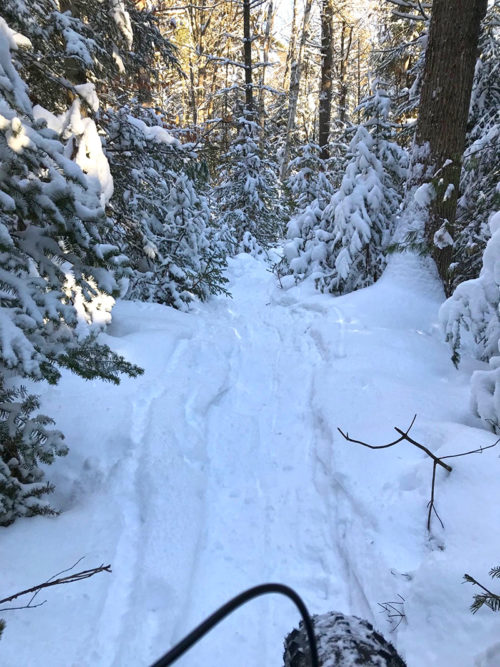Steve
Do you ride with studded tires, a fat bike or both?
Generally, both—studded tires on a fat bike.
What is your fat bike?
I ride a custom built 2018 Farley 7.
Studs are essential in icy conditions. Even if it looks like just snow, you can hit a patch of hidden ice and then you really need the studs. Fat bikes—especially with tires that have big knobs—are good for fresher snow. Add studs and you can ride all winter.
How is winter riding different from summer riding (other than the temperature)?
Access. You can get into places you normally can’t go. Snowmobile trails across water, for instance. Areas that are normally soft get firm enough to ride. Also, you can go places you don’t usually go in the summer, like on snowmobile trails in the White Mountains. After a thaw, you can watch the regional weather maps and forecasts and anticipate which areas are going to have freezing temperatures first. As soon as it drops below freezing, it gets firm enough to ride.
What about snowmobile trails? Does it work with both bikes and snowmobiles using the same trails?
Anywhere there are multi-use trails there’s going to be some conflict, but generally sledders don’t mind the fat bikes as long as they don’t leave ruts. In Wisconsin, they’ve dealt with this issue by recommending a max PSI of 5, so that the fat bike tires don’t make an impact on the snowmobile trails.
How much does a fat bike cost, typically?
They’re expensive. An entry-level regular or plus bike starts in the $1,000-$1,200 range, but an entry-level fat bike starts at about $1,700.
Why? They don’t even have suspension.
I figure it’s due to the rims and tires.
Those cost a lot? For instance, how much is a pair of studded fat tires?
They range from $170 to $250.
Are fat bikes good for riding in fluffy snow?
Riding in 10 inches of new snow? No way. Your only choice is to ride snowmobile trails, and even then it’s harder, because it’s still soft, like sand. You can ride as hard as you normally do, but you won’t get as far because you’re slower. But if it snows 4 inches, then 5 inches, then another 4 inches—we can “ride it in.”
It’s important to keep your eyes up and keep a steady cadence, to avoid spinning out or breaking through the crust. Now there are places that use “snow dogs” to groom fat bike trails. Yesterday I read on Facebook that they’d groomed trails in Gorham [after the thaw and refreeze, with snow in the forecast]. I almost drove to Gorham last night.
Doesn’t it get too cold? How do you deal with the cold?
Layer up. I like to stay a little warm—better a little too warm than a little too cold. I have pants made specifically for fat biking, knee warmers, disposable hand/foot-warmer packets. Outer mitts or “pogies” are usually insulated and newer ones have pockets for things like your phone. I also carry an insulated jacket, an emergency blanket, and fire sticks—just in case.
Do you get cold when you stop, like if you have a mechanical issue?
Chances for a mechanical are less in the winter because there’s no debris, and you’re less likely to get a flat.
How cold is too cold to ride?
I would always try. There are Facebook discussions with people getting out there when it’s forty below. If they can, I can. I would just wear more gear than ever.
If conditions were good everywhere, where would be your favorite place to winter bike?
Western Maine and the White Mountains. Around here: Bowdoinham and Sabbatus, on the snowmobile trails.
How long have you been mountain biking?
26 years.
How long winter biking?
22 years.
Do you think people should be experienced at mountain biking before they try winter biking?
No, I don’t think so. Ice does require a little more effort psychologically but for the most part, fatbiking on snow is much easier than mountain biking. The technicality is mostly taken away.
Steven Kilburn runs the Gorham Bike & Ski in Brunswick and calls the Bath area trails his home turf for winter riding.
Michelle & Andy
Do you ride a fat bike, a bike with studded tires, or both?
Andy: We both have Specialized Fatboy fat bikes with 26”x 4.65” tires. Eventually we could go tubeless and even studded but for now we’ll ride our regular 29” bikes when it’s icy and fats when not.
Studded tires are best when it’s icy and a fat bike when it’s snowy?
Andy: When it’s concrete-crunchy, you can ride with any bike, you just have to be careful to get off when there’s ice. When it’s glare ice, you want studs. But metal studs can slide on rock, so you still have to be careful. When it’s packed, a bit squishy, or up to a couple inches of fresh snow, you want a fat bike.
The ideal is studded tires on a fat bike, but that can get expensive. Regular fat bike tires are around $100 each. With studs they can be $200-250 each. You can save some money by getting a kit with “studdable” tires and putting the studs in yourself.
Get a sensitive pressure gauge for low-pressure tires. Regular gauges make it hard to see what kind of pressure you have.
What pressure do you use?
Michelle: 4 pounds.
Andy: 6 pounds.
How else is winter riding different from summer riding (other than the temperature)?
Michelle: Packed snow trails can be very narrow and if you get off the trail you can sink into deep snow. You really have to be careful to be in the middle of the trail.
Andy: Fat bikes are fun. You feel like you can ride over anything. They take some getting used to but a lot of people love them.
There’s the whole tubes vs. tubeless thing, too. Going tubeless is very reliable because you really don’t get flats. My only caution with that is if you do somehow get a flat out there—whether you’re tubeless or with a tube—it’s hard changing a fat tire. Last week I was letting some air out through the presta valve on my tubeless and the core just fell out. And I didn’t bring an extra tube.
Michelle: We fished around in the snow, but couldn’t find it. He had a cold 3-mile walk back to the car.
Another thing is it’s louder to have studs, especially when riding on a frozen pond or stream, the studs make a racket. It’s really fun though. You can ride all the way around a pond or a lake. You just have to be sure there’s enough ice. We don’t ride on ponds unless we know it’s really thick.
How long have you both been riding mountain bikes?
Michelle: Since ’88. Our first bikes were Diamondbacks. It was one of the first things we saved up for.
How long have you been winter biking?
Andy: The same. I think we had GTs that we got at Allspeed when Gary owned it. I made our first set of studded tires with regular tire studs for car tires. I drilled a bunch of holes in each tire, pushed the studs through from the inside then lined them with road bike tires—with the bead cut off and cut to fit—to protect the tube. They were skinny and heavy but we got some great rides on Highland Lake and Pride’s Corner back in the 90’s.
Doesn’t it get too cold in the winter? How do you deal with that?
Andy: If you’re just getting into winter riding and you have flats [flat pedals] you can ride with regular heavy shoes or boots.
Michelle: Not snow boots. Those were so uncomfortable. Do not do that.
What about those cover booties that go over your regular clipless shoes?
Michelle: They’re good to start, but they’ll only last a season because you’re constantly bashing them on your pedal when you clip in.
Andy: 45 North makes good clipless winter boots. They look like Doc Martins. Get them big and you can wear extra socks.
We wear balaclavas, and layers. It’s like riding in the fall. If you’re comfortable at the start, you’re going to be too hot. Better to start a little cool and bring an extra layer in your pack.
Pogies?
Andy: Not yet, though that’s next. We wear gloves. I have a pair of Hestra telemark split mittens with the index finger separate from the rest of the fingers.
Right, because we really should only use one finger for braking. What about the lobster gloves with two “fingers”—one for index and middle, one for ring finger and pinky?
Michelle: Those can be a problem because braking with two fingers instead of one is harder on your tendons. My carpal tunnel got bad when I was braking with two fingers.
What’s better, snowmobile trails or singletrack?
Michelle: Singletrack is definitely a better workout. It’s harder.
Andy: The bridges can be sketchy because they get “crowned” and are hard to ride.
Snowmobile trails are great because there’s more of them. They’re also wide and open.
A good safety tip is to wear your lights when you’re riding snowmobile trails [even in the daytime] because they look for the lights of oncoming snowmobiles so they’re more likely to see you sooner. But you can hear them coming long before they know you’re there, so it’s courteous to get off to the side of the trail and let them by.
Do you ride at night?
Both: Oh yeah.
How cold is too cold for you to ride?
Both: single digits.
Michelle: we rode at Carrabassett this year when it was 5 degrees. We don’t know for how long because Strava stopped when our phones froze.
What do you like about winter biking?
Michelle: it’s better than being in the gym!
Both: Being outdoors. The tracks in the snow. You see all kinds of animal tracks.
If you knew conditions were great everywhere, where would be your favorite place to winter bike?
Locally, Gorham or Hadlock [Park]. Hadlock is technical, more challenging. We haven’t gone too far away. But definitely Carrabassett Valley and Kingdom Trails.
Do you think people should be experienced at mountain biking before they try winter biking?
Yes, probably, as it can be challenging for even a veteran. Off-camber and even a small hill can be tricky. Glare-ice lakes are fun but you really can’t corner like you can on a regular mountain bike.
Andy and Michelle Haynes are the owners of Bayview Signworks in South Portland and winter ride all over greater Portland.
Tracy
What is your winter bike?
A Norco Bigfoot 1 from Allspeed. With a dropper post. Because your feet sink into the snow. It serves a different purpose in winter. I never thought I’d want a dropper. But on my fat bike I’m constantly using it. I use it to get on and off the bike.
Studded tires on the fat bike?
No. Studded fat tires can be extremely expensive. Next year. But I have studs on my [Santa Cruz] Juliana. When I get studs on the Norco that will save the Juliana from salt and sand.
The fat tires are lighter than you would think. In terms of weight, my fat bike is not noticeably different than my regular bike. Going up hills is a little more torturous, though.
What conditions are good for a fat bike versus a regular bike with studded tires?
Softer snow. Today Robinson [Woods] won’t be packed enough for the Juliana, I’ll ride the Norco today.
Is that because when it’s not packed, you’re more likely to break through or sink in with skinny tires?
Yes. That’s why at Sugarloaf you’re required to have fatter tires. They’re now allowing fat bikes to use some of the nordic trails. You don’t want to sink in and ruin the trail for skate skiers. We stay out of the classic tracks, of course. There’s an 8-mile loop you can do from the nordic center. And then you can go across to the NEMBA trails where the huts are. You can ride anywhere there.
Everyone’s excited about the trails that are getting groomed, like in Gorham and Winnick Woods. Groomed trails are better because they’re wider?
They’re a bit wider. But the main thing is they’re smoother. If the grooming is timed right, the trail can be like a sidewalk. It’s great. In Robinson, there’s a lot of walkers and dogs that help pack it down, but it’s bumpier. Winnick [Woods] has been good too.
I haven’t done the whole Cape loop on a fat bike yet. That’s usually 20-30 miles. When I ride it with skinny tires, it’s faster and I can do a whole loop.
Is that because you’re being more careful when you ride without studs on your fat bike?
The fat bike is slower. But today it will be way better on a fat bike because it’s not packed down yet. Fat tires float better because they’re wider and have low pressure. You have to play around with pressure a lot in winter.
Do you carry a pressure gauge?
Yeah, I got a low pressure gauge this year. You spend more time dialing it in than you do on regular mountain bike. You experiment more.
Doesn’t it get too cold riding in the winter? How do you deal with that?
I tend to run hot. I get TOO hot. It can be 5 degrees, so I bundle up, but then I’m shedding layers. Moisture management is key. You have to find clothes that wick. I wear an expedition-weight long underwear top with a fleece. And a puffy jacket. I ditch the puffy within the first five minutes.
And do you wear boots instead of bike shoes?
Regular hiking boots on flat pedals. If it’s super cold I’ll put toe warmers in.
And on your Juliana?
I put flat pedals on that too, for the winter. The clipless pedals get ice in them.
Aren’t the hiking boots too much—too bulky?
Not for me. They’re important because you’re steping in the snow. And if you step off the trail, sometimes you’re knee deep in snow.
And what about your hands?
I wear winter mountain bike gloves. If it’s below 15 degrees I use pogies—bar mitts. Last week it was 4 degrees at Sugarloaf and my hands were too hot with pogies.
If it’s really freezing I’ll wear an old ski helmet. It’s much warmer than a bike helmet. But I wear a balaclava under either my bike helmet or my ski helmet. The bike helmet alone is sometimes still too cold! If it’s snowing I’ll wear ski googles, too, but usually I just wear my regular mountain bike glasses.
I wear winter bike tights with Shredly bike shorts over them, because my butt gets cold, and they have pockets. Pockets on your leg are easier than pockets on your jacket. Some people have big cargo bike bags that hang from the top tube.
And I wear a windproof layer for long downhill sections.
I’m looking at your picture, does your Camelback have an insulated tube?
Yes. And here’s an important tip I got from Mike Sandora: Blow the water back in so it’s not in the tube. Otherwise it freezes. Sometimes it freezes anyway. It’s a challenge to drink enough because you sweat so much and it’s so dry out.
How cold is too cold to ride?
Hm… Nothing. One time at Sugarloaf it was minus 20, and I was fine. The hardest part is getting hot and keeping clothes dry.
What do you like about winter biking?
It’s just fun. It’s beautiful in the woods, with the snow, it’s so pretty. And now it’s really accessible, because they’re grooming and we have fat bikes. Without a fat bike I spent a lot of time waiting. It opens up a lot more days.
How long have you been riding a mountain bike?
Since 1991.
How long winter biking?
Since 2008. I went on my first winter ride on my regular bike with no studs—one of those rare days where it was doable—and regular shoes, on a day that was 7 degrees and I had a blast. I gradually got all the gear over the years. I held off on the fat bike for a while though because in Cape you almost always need studs and I could just ride my regular bike with studs. Over Christmas break this year, though, the conditions were perfect for fat biking but not great for skinny tires and I was being tortured by everyone’s photos with fat bikes. I had to get one! I walked into Allspeed and walked out with a fat bike. I’ve never done that! I rode it every day for the first three weeks I had it. It’s just so fun.
How is riding in winter different from summertime riding (other than the temperature)?
Falling is different. You’re not crashing, you’re falling because you’re going off the trail and now you’re up your knees in snow.
With studded tires, do not put your foot down. Your studs have way more traction than your shoes do.
If you knew conditions were great everywhere, where would be your favorite place to winter bike?
I haven’t gone that many places yet. Haven’t been to Gorham yet, but based on how much I love it in summer, I think I’ll like it in the winter. Maybe Bradbury? I haven’t been there yet in the winter. Sugarloaf, of course.
Do you think people should be experienced at mountain biking before they try winter biking?
No. It’s generally easier because the roots and rocks are covered by the snow, so less technical skills are required. Even some of the gnarly skinny bridges are totally covered, and you sometimes can’t even tell they’re there. Of course, there’s the safety aspect—where a newbie might not know how to change a tire or make other minor bike repairs, and in winter the cold could make an extended stop in the woods dangerous in this situation—so I’d still recommend going with someone who is familiar with the sport.
Tracy Sesselberg is a Single Track Sister who winter rides a lot in Cape Elizabeth and Carrabassett Valley.
Want to try it?
You can pick up studded tires in any bike shop and try them on your regular mountain bike. If you want to try fat biking, The Bangor Daily News posted a story with some great resources last year: Fat Tire Biking in Maine: Rentals, Trails & Fattty Festival.
And be sure to keep an eye on the GPNEMBA Facebook page. They bought a “snow dog” this year and hope to start a winer grooming schedule for areas of Falmouth, Bradbury Mountain, Cape Elizabeth and Gorham.


